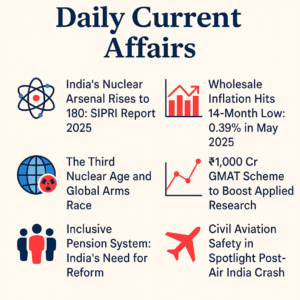Stay ahead with the 18 June UPSC Current Affairs roundup, tailored for IAS aspirants. Today’s highlights include India’s rising nuclear arsenal, inflation hitting a 14-month low, reforms in the pension system, aviation safety alerts, and a ₹1,000 Cr push for applied science under GMAT. This daily update is your one-stop source for both Prelims and Mains preparation, with clear facts and analysis rooted in UPSC standards. Don’t miss this essential revision set!
1.India’s Nuclear Arsenal Rises to 180: SIPRI Report 2025
What’s the News?
India increased its nuclear warhead count from 172 in Jan 2024 to 180 in Jan 2025, as per SIPRI’s 2025 annual report. This marks an ongoing nuclear modernization drive, seen across most nuclear-armed states.
Key Points for UPSC
-
India: 180 nuclear warheads (up from 172 in 2024).
-
Developing canisterised missile systems for rapid deployment.
-
Pakistan’s count stable at 170.
-
Total global nuclear stockpile: 12,241 warheads; 9,614 in military use.
-
U.S. and Russia still possess the majority.
Global Developments
-
China’s warheads increased to 600 (from 500).
-
Russia’s deployed stock: 1,718 warheads.
-
New START Treaty to expire in 2026 with no successor.
-
Rising arms race globally—erosion of trust in disarmament regimes.
Conventions & Treaties
-
NPT (1968) – India remains a non-signatory.
-
CTBT – Not yet ratified by several nuclear powers.
-
New START Treaty – Limits U.S.–Russia strategic arms; future uncertain.
Implications
-
Escalating arms competition in South Asia.
-
Enhances India’s second-strike capability and credible minimum deterrence.
-
Complicates global nuclear disarmament efforts.
UPSC Quick Facts
-
India: 1,770 deployed + 5,177 in reserve.
-
9 nuclear states: US, Russia, UK, France, China, India, Pakistan, Israel, N. Korea.
-
SIPRI notes increasing focus on pre-emptive-capable technologies.
2.The Third Nuclear Age: New Threats, Fading Treaties
What’s the News?
We’re witnessing a Third Nuclear Age, where traditional arms control is collapsing and new technologies plus rising powers reshape the global nuclear order.
Key Points for UPSC
-
First Age: Cold War-era US–USSR deterrence.
-
Second Age: Post-Cold War disarmament hopes.
-
Third Age: Strategic chaos, new entrants (China, NK), cyber threats.
Global Context
-
Russia relocates tactical nukes to Belarus.
-
China rapidly modernizing for parity with the U.S..
-
U.S. updating nuclear posture post-Trump.
-
Rising risks from non-state actors and cyber warfare.
Conventions
-
New START ends in 2026.
-
NPT’s Article 6 on disarmament is now weakened.
-
CTBT remains ineffective due to non-ratification.
Implications
-
India caught in a tense nuclear triangle with China & Pakistan.
-
Modernization by adversaries demands doctrine flexibility.
-
Higher risk of strategic miscalculation.
UPSC Quick Facts
-
3rd Age = Collapse of arms control.
-
Tactical nukes returning to war doctrine.
-
Nuclear deterrence seen as less reliable.
3.Falling Inflation, But Uncertainty Looms
What’s the News?
India’s WPI inflation has dropped to 0.39% in May 2025, a 14-month low, easing concerns over price rise—but global and domestic volatility remains a threat.
Key Points for UPSC
-
Primary food, oil, and vegetable prices dropped.
-
CPI may follow downward trend.
-
RBI maintains neutral policy stance.
Recent Trends
-
Stabilizing global commodity prices.
-
Edible oil imports steady.
-
Climate uncertainties could reverse the trend.
Policy Implications
-
Opportunity for increased capital expenditure.
-
RBI might hold interest rates.
-
Fiscal prudence needed due to external shocks.
UPSC Quick Facts
-
WPI May 2025: 0.39%.
-
Inflation driven by seasonal, global patterns.
-
Key concern: food security amid climate risks.
4.Science Needs Freedom to Flourish
What’s the News?
A ₹1,000 crore scheme has been launched under GMAT (Grant for Marketable Applied Technologies) to promote industry-driven scientific research.
Key Points for UPSC
-
Shift from academic research to marketable tech.
-
Part of Atmanirbhar Bharat and startup push.
-
Scientists encouraged to address real-world problems.
Global Context
-
Mimics global trend of applied R&D funding models.
-
Tensions between commercial science and basic research.
Concerns & Benefits
-
May dilute pure research goals.
-
Encourages MSME, startup collaboration.
-
Promotes demand-based innovation in India.
UPSC Quick Facts
-
₹1,000 crore GMAT scheme.
-
Promotes commercial, applied innovation.
-
Science meets market needs via public funding.
5. India Needs an Inclusive Pension System
What’s the News?
India’s pension framework remains fragmented and exclusionary, especially for informal workers and women, amid an aging population.
Key Points for UPSC
-
Only 13% of workforce under formal pension coverage.
-
Most elderly rely on family or savings.
-
Need for a tiered pension model.
Global Best Practices
-
Netherlands, Japan: mix of public-private systems.
-
Emphasis on digital delivery and portability.
Policy Suggestions
-
Universal basic pension.
-
Tax-incentivized contributory schemes.
-
Market-based retirement funds.
UPSC Quick Facts
-
Elderly to reach 20% of population by 2050.
-
Informal sector = ~90% of workforce.
-
Schemes like EPFO, NPS insufficient for informal class.
6.Rebuilding Trust in Indian Aviation
What’s the News?
Post the tragic Air India crash (2024), India must overhaul its civil aviation safety, oversight, and training mechanisms.
Key Points for UPSC
-
DGCA under scrutiny for safety oversight.
-
ICAO audits flagged poor maintenance checks.
-
Similarities with earlier crash incidents raise concerns.
Global Standards
-
U.S. FAA and EU EASA offer better regulatory models.
-
India needs to catch up as air traffic grows.
Policy Priorities
-
Revamp pilot training and licensing norms.
-
Invest in indigenous aircraft production.
-
Ensure transparent crash investigations.
UPSC Quick Facts
-
India: 3rd-largest domestic aviation market.
-
ICAO flagged India’s aviation compliance.
-
Rising demand = need for robust safety infrastructure.
